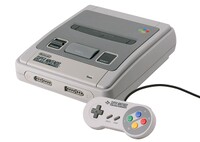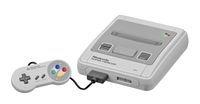Super Nintendo Entertainment System: Difference between revisions
No edit summary |
No edit summary |
||
| Line 14: | Line 14: | ||
Image:DKC2.jpg|<center>[[Donkey Kong Country 2: Diddy's Kong Quest]] | Image:DKC2.jpg|<center>[[Donkey Kong Country 2: Diddy's Kong Quest]] | ||
Image:DKC3 Cover.jpg|<center>[[Donkey Kong Country 3: Dixie Kong's Double Trouble!]] | Image:DKC3 Cover.jpg|<center>[[Donkey Kong Country 3: Dixie Kong's Double Trouble!]] | ||
Image:mism1.jpg|<center>[[Mario is Missing!]] | |||
Image:MarioPaintBox.jpg|<center>[[Mario Paint]] | Image:MarioPaintBox.jpg|<center>[[Mario Paint]] | ||
Image:Mariopicross2.jpg|<center>[[Mario's Super Picross]] | Image:Mariopicross2.jpg|<center>[[Mario's Super Picross]] | ||
Revision as of 17:46, January 7, 2008
The Super Nintendo Entertainment System (often abbreviated to SNES) is a video game console created by Nintendo. It was far superior to the original NES and rivaled in performance to the Sega Mega Drive/Genesis. It had many great-quality games, including Super Mario World, Super Mario RPG: Legend of the Seven Stars, and Super Mario All-Stars. Along with those titles came perhaps the less popular Mario Paint.
The time of the SNES is viewed by some "the golden age of gaming". It stopped being produced in 1999, but the Famicom model was made until 2003. New games were made until 2000. It remained popular throughout the 32/64 bit era.
Super Famicom
The SNES was based on a Japanese console called the Super Famicom. Famicom was a portmanteau of Family and Computer. There are obvious performance and aesthetic differences between the two consoles.
Game Gallery
- DKC.jpg
- SMK BoxCover2.jpg
- 250px-Super mario world box.jpg
- WWOODSbox.JPG
- Boxartfront.jpg
- Box ysafari pal.jpg










